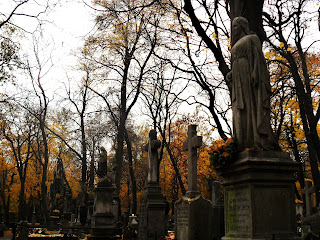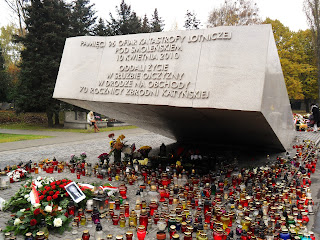All Saints Day in Poland
 I am in Warsaw this week, visiting my aunts and cousin. I also have a couple of friends living in Poland now, so it's good to go visit and catch up with them, too. I was also here at the same time last year (the last weekend in October always includes a four-day weekend in Bulgaria so I took advantage of some extra time off to take a "fall break" from school). I can say with absolute certainty that Halloween is definitely not a big deal in this country. Besides a few displays in cafes and shops, and a couple of posters advertising parties in Warsaw, I didn't notice much going on to celebrate the holiday. Which makes sense. It isn't something which has a tradition here, unlike in the States where we spend so much time and money on costumes, trick-or-treating and decorating our homes. However, the origins of Halloween (or All Hallow's Eve) are very closely linked to an important holiday in the Polish calendar: All Saints Day, celebrated on November 1st.
I am in Warsaw this week, visiting my aunts and cousin. I also have a couple of friends living in Poland now, so it's good to go visit and catch up with them, too. I was also here at the same time last year (the last weekend in October always includes a four-day weekend in Bulgaria so I took advantage of some extra time off to take a "fall break" from school). I can say with absolute certainty that Halloween is definitely not a big deal in this country. Besides a few displays in cafes and shops, and a couple of posters advertising parties in Warsaw, I didn't notice much going on to celebrate the holiday. Which makes sense. It isn't something which has a tradition here, unlike in the States where we spend so much time and money on costumes, trick-or-treating and decorating our homes. However, the origins of Halloween (or All Hallow's Eve) are very closely linked to an important holiday in the Polish calendar: All Saints Day, celebrated on November 1st.
 This is a public holiday, and most Poles visit the cemeteries to pay their respects to deceased loved ones. I was interested in the custom, so I went with my family to Powązki Cemetery, where my great-uncle Aleksander and his first wife are buried. The first thing I noticed about this holiday is how well-organized it is. Special bus routes are added to service the cemeteries in Warsaw, and transportation workers are available to direct passengers and traffic. We went relatively early in the day, but the crowds got worse as late morning arrived. Outside of the cemetery gates were vendors selling candles, tissues, flower arrangements, wreaths, and all kinds of candy and snacks. There were television crews set up outside the main entrance (being the most famous cemetery in the city, it is the final resting place of many well-known actors, musicians, writers and politicians). It's basically the Père Lachaise of Warsaw. More recently, is became the location for a somber memorial to the victims of the April 2010 plane crash which killed nearly a hundred people, including many prominent members of the government, the president and his wife. The memorial is made from two "wings" split in the middle and flanked on either side with the graves of some of the victims of the crash. On Tuesday there were many visitors to the site, leaving candles, photos and flowers in memory of the tragedy. The aftermath of the crash has had all kinds of repercussions for the direction of Polish politics, especially in the growing rise of more radically conservative nationalism. But on this day, people came to remember the individuals who lost their lives, along with loved ones. The whole day seemed more cathartic than depressing, because so many people came to perform these rituals, and then continued on with their lives. It also pointed out one of the major contentious issues of contemporary Polish society: the role of the Catholic Church in public life. While this institutionalized "day of remembrance" serves as a (probably) necessary outlet for grief, the teleological role of religion is also narrowing the possibilities for a plurality of identity within Poland. It's clear that this is already a divisive subject, not only between religious and secular groups but within the church itself.
This is a public holiday, and most Poles visit the cemeteries to pay their respects to deceased loved ones. I was interested in the custom, so I went with my family to Powązki Cemetery, where my great-uncle Aleksander and his first wife are buried. The first thing I noticed about this holiday is how well-organized it is. Special bus routes are added to service the cemeteries in Warsaw, and transportation workers are available to direct passengers and traffic. We went relatively early in the day, but the crowds got worse as late morning arrived. Outside of the cemetery gates were vendors selling candles, tissues, flower arrangements, wreaths, and all kinds of candy and snacks. There were television crews set up outside the main entrance (being the most famous cemetery in the city, it is the final resting place of many well-known actors, musicians, writers and politicians). It's basically the Père Lachaise of Warsaw. More recently, is became the location for a somber memorial to the victims of the April 2010 plane crash which killed nearly a hundred people, including many prominent members of the government, the president and his wife. The memorial is made from two "wings" split in the middle and flanked on either side with the graves of some of the victims of the crash. On Tuesday there were many visitors to the site, leaving candles, photos and flowers in memory of the tragedy. The aftermath of the crash has had all kinds of repercussions for the direction of Polish politics, especially in the growing rise of more radically conservative nationalism. But on this day, people came to remember the individuals who lost their lives, along with loved ones. The whole day seemed more cathartic than depressing, because so many people came to perform these rituals, and then continued on with their lives. It also pointed out one of the major contentious issues of contemporary Polish society: the role of the Catholic Church in public life. While this institutionalized "day of remembrance" serves as a (probably) necessary outlet for grief, the teleological role of religion is also narrowing the possibilities for a plurality of identity within Poland. It's clear that this is already a divisive subject, not only between religious and secular groups but within the church itself.
This is definitely something more to ponder than just jack-o-lanterns and costumes!
No comments:
Post a Comment